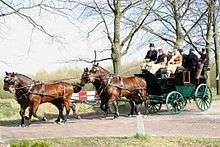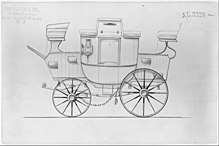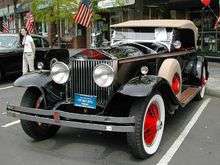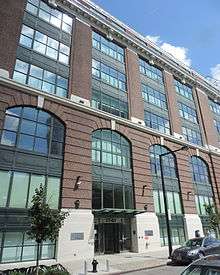Brewster & Co.
Coordinates: 40°45′02″N 73°56′20″W / 40.7505°N 73.9389°W


Brewster & Company was an American custom carriage-maker and automobile coachbuilder founded by James Brewster in 1810 and active almost 130 years. Brewster began in New Haven, Connecticut and quickly established a reputation for building America's finest carriages. He opened his first New York City showroom at 52 Broad Street in 1827.
Brewster's first known bodywork on an automobile was on an electric car in 1896 then a gasoline-powered Delaunay-Belleville chassis in 1905. Eventually they built bodies on chassis from a variety of makers winning a particular link with Rolls-Royce America Inc at Springfield.
Between 1915-1925 they produced their own line of opulent and expensive automobiles at their plant in Long Island City. The Great Depression began in 1929 and luxury car sales fell away. In 1934-35 they built and sold luxury bodies on 135 Ford V8 chassis but bankruptcy proceedings began in mid-1935 and the last of Brewster's assets were sold by auction in 1937.
Ownership
Over the lifetime of this business it passed through many hands but they were usually hands linked to the founder's family.[1]
Carriages
In 1804 James Brewster became an apprentice to carriage builder Colonel Charles Chapman when he was 16 years old. He considered pursuing a life in the military, achieving the rank of Lieutenant in the Northampton militia, but ultimately decided "coachmaker with a competency" sounded better than "General Brewster". James had $30 when he completed his apprenticeship, heading out for New York in 1809 but there were delays along the way.[1]
James was exploring New Haven, Connecticut, and had walked into a carriage manufactory. He became journeyman under John Cook, who owned a carriage-making shop. By 1810, he had finished working under Cook (having saved $250), gotten married, and opened up his own carriage shop, Brewster Carriage Co. This was the period when four-wheels light carriages began to replace two-wheeled carriages.
.jpg)
for President Andrew Jackson
His coaches were of exceptional quality and after a few years, to meet demand he had to buy the carriage shop of John, his former employer.[1]
Brewster carriages began to get noticed in the larger cities, and he opened up a showroom and warehouse on Broad St. in New York City. To keep his best workers loyal, James paid the highest wages in cash every week. In contrast other small establishments paid on and off and not always with cash.[1]
Eventually James retired, with his younger son Henry running the New York branch, which became Brewster & Co. and his elder son, James B., running the rival firm of J.B. Brewster & Co. In 1883, Henry's 17-year-old son William joined his business. After traveling about Europe to see and learn from the finest coachbuilders, William came home with an extremely discerning eye, scraping an 'X' with a pen knife on finished body panels that showed any imperfection destroying the craftsman's work and requiring a complete re-finish at the craftsman's expense. Later William adopted the slogan "Carriage Builder for the American Gentleman."[1]
 Landau
Landau Brougham
Brougham Park Drag
Park Drag Victoria
Victoria Pony Phaeton
Pony Phaeton
Automobile bodies
In 1905 Brewster became importers for Delaunay-Belleville, the most desirable French car of the time. This marked their first venture into automobile body building, beginning their history of providing coachwork for prestigious autos. Before 1914 most Brewster vehicle sales were on Delaunay-Bellevilles and other French makes. In 1914 Brewster was carefully selected to be sales agents for Rolls-Royce and they became the main body suppliers for Rolls-Royce in the U.S.[1]

By 1925 Brewster's car had few sales, trading with Europe had resumed, and Rolls-Royce America Inc was expanding and gaining bargaining power against Brewster. Executives from Rolls-Royce of America and Brewster met, and decided on the purchase of Brewster & Co. and their debt. Brewster had chassis fitted with temporary seats and protection and driven from Rolls-Royce's Massachusetts plant to the Brewster Building in Long Island City, New York for bodies. The Rolls-Royce showrooms offered 28 standardized body styles so as to deliver cars to customers quicker and for a lower price. Customers could to purchase models directly from the showroom as well.[1]
After Rolls-Royce America Inc folded, from 1931 to 1934 Rolls-Royce Phantom II chassis were shipped directly from Britain to Brewster's large facility in Long Island City.[1]
Brewster automobiles
.jpg)

Most bodies were ordered to fit customers' imported chassis. Once Europe went to war in the summer of 1914 supplies were at risk. Brewster began to build its own cars after the 1915 sinking of the British liner Lusitania and continued until 1925. Though smaller than their usual chassis — for navigating the streets of Manhattan — they cost as much as "a Packard Twin Six limousine plus a fleet of five Model T Ford roadsters." Brewster's own cars were easily recognizable by their oval radiators and shiny patent-leather fenders. They were powered by four-cylinder sleeve-valve Knight engines and often fitted with Brewster's own special design of windshield.[1]

By the time of the Great Depression which began at the end of 1929 there was strong sentiment against the wealthy and their archetypal Brewster-bodied Rolls-Royces and Brewster's bodies were not selling well. In 1934 sales chief, J.S. Inskip, who had taken control of operations in the hope of saving Brewster bought 135 Ford V8 roadster chassis and designed a body for them easily identified by its swoopy fenders and a heart-shaped grille. Stylish and sold for $3,500 it was a hit at the 1934 New York Auto Show. The bodies were worth more than the chassis. These cars were branded Brewster and sold at Rolls-Royce showrooms.[1] Inskip marketed the cars to New York celebrities (see Notable Owners), with whom it became popular.
The Ford Brewster project was initially profitable but soon Brewster was taking losses and its bondholders and directors insisted on closing down the firm. Bankruptcy proceedings were instituted in July 1935.
Liquidation
On August 18, 1937 Brewster's remaining assets were sold at public auction. The Rolls-Royce dealership and body business continued on the same premises under the name J S Inskip Inc. run by former sales chief John Inskip. The spun-off Brewster Aeronautical Corporation continued to operate during World War II.
Fame
Brewster & Co. presented the following carriage configurations at the Exposition Universelle (1878) in Paris: Brougham, Lady's Brougham, Cabriolet, Landau, Racing Sulky, Road Wagon, Park Drag, American Trotting Phaeton, Lady's Phaeton, T-Cart, Two-Wheeler, a double-suspension Victoria, and a Whitechapel Wagon.
To the surprise of everyone, Brewster won the Gold Award, the highest honor. His was the only American firm to win such at the Exposition. Henry was even personally awarded the Legion of Honor by the President of France, while his employees received honors as well.
Brewster received many more honors at the 1893 Chicago World’s Fair (aka Columbian Exposition, marking the 400th anniversary of Columbus sailing to the New World.)
"You're the top! You're a Ritz hot toddy. You're the top! You're a Brewster body." The coachbuilder was immortalized in the Cole Porter song, "You're the Top".
The manager of New York's National Horse Show, Edward King, was once asked whether he considered Brewster to be the Tiffany of carriage manufacturers: "My opinion is that Tiffany was the Brewster of jewelers." (indeed Tiffany was the younger company.)
Colonel Paul Downing for American Heritage Magazine, wrote in 1956: "However, it is doubtful that it can honestly be said that America took her place in the world of really fashionable carriages until the firm of Brewster & Company of Broome Street took the lead. It became a saying in the trade that a new style was of no value until it was established by Brewster."
- Brewster kept records of all family crests and colors of its customers. The Astors' was a blue, J. P. Morgan's dark green, and the Vanderbilts' was a shade of maroon. These reserved colors sometimes made it difficult for new customers to choose a body color.
- Brewster formulated a secret oil-based finish, which required much less maintenance than varnishes used at the time. Other firms tried and failed to duplicate it.
- In response to chauffeurs regarding glaring street lights at night, Brewster styled a windshield with a four-pane design after much research. Although it wasn't patented, it became known as a "Brewster windshield" and was widely copied by body builders and production automobiles.
- Brewster has also made speedboat hulls.
- Brewster made children’s pony carts as well as coaches designed to hold 20 or more people.
- Alumni
- Many automotive engineers and designers had their start at Brewster. The designer and engineer of Pierce-Arrow's cast-aluminum bodies from 1904–1920, James Way, first worked at Brewster. Head of Lincoln's coachbuilding division Henry Crecelius Sr. was persuaded to work there by Edsel Ford, from Brewster. Raymond Dietrich started at Brewster as a draftsman before being fired for secret designing for other makes. Harry Lonschein founded Rollston after starting out at Brewster.
.jpg)
- Notable Owners
- Louis Comfort Tiffany - Brewster's second gasoline auto chassis, a Panhard et Levassor
- John D. Rockefeller, Sr. - His Crane-Simplex had two Brewster bodies, for summer and winter.
- John D. Rockefeller, Jr.
- Frank Winfield Woolworth
- Vincent Astor
- Brewster V8 owners
.jpg)
- Edsel Ford - Purchased the first Brewster-bodied Ford V8 available
- Al Jolson
- Cole Porter
- Lily Pons
- Gertrude Lawrence
- Fred Waring
- Victor Moore
Edsel Ford
15 of the cars with a Ford V8 chassis were made with the 1935 Ford grill. Edsel Ford acquired the first shipped example. A 'one off' custom on a stretched 127-inch wheelbase, a 1934 Brewster Town Cabriolet DeVille (chassis number: 18-802233; engine number: 49493; Brewster build number 9002), which was the third Ford Brewster and the only that did not use the normal Brewster front end. Instead (at Edsel's request) 1934 Ford grill was installed. It is also the only example made with a standard Ford dash instead of the Brewster dash, 16 inch wheels in place of the standard 17s, and a banjo steering wheel. Edsel Ford kept it at a New York Ford Dealer, where he and his family could use it while in New York. In 1939, he had it retrofitted with a 239 Mercury flathead V8 engine that produced nearly 100 horsepower. It is one of Edsel Ford's few personal cars and still survives today in remarkable condition, unrestored. It was presented by RM Auctions at Automobiles of Amelia in 2008 where it sold for $198,000.
The Brewster-bodied Ford chassis Town Car with heart-shaped grill is the only classic Ford designated by the Classic Car Club of America.
References
External links
| Wikimedia Commons has media related to Brewster & Co.. |
